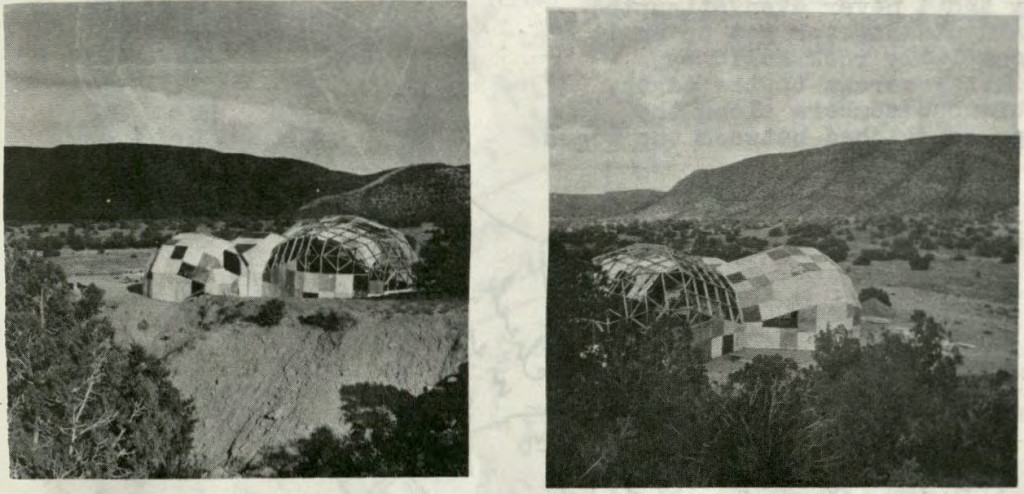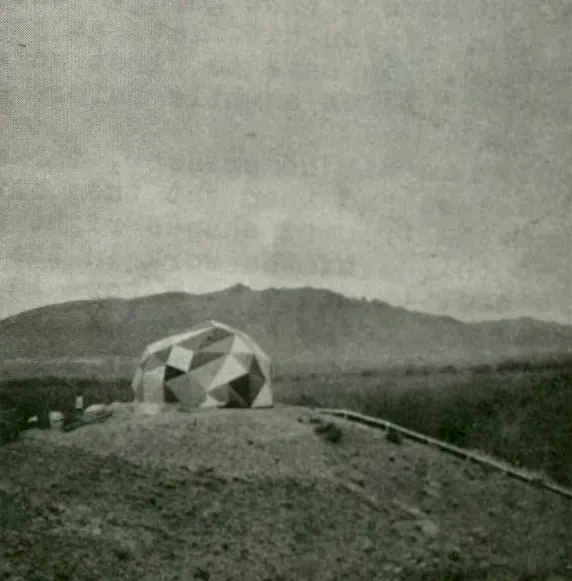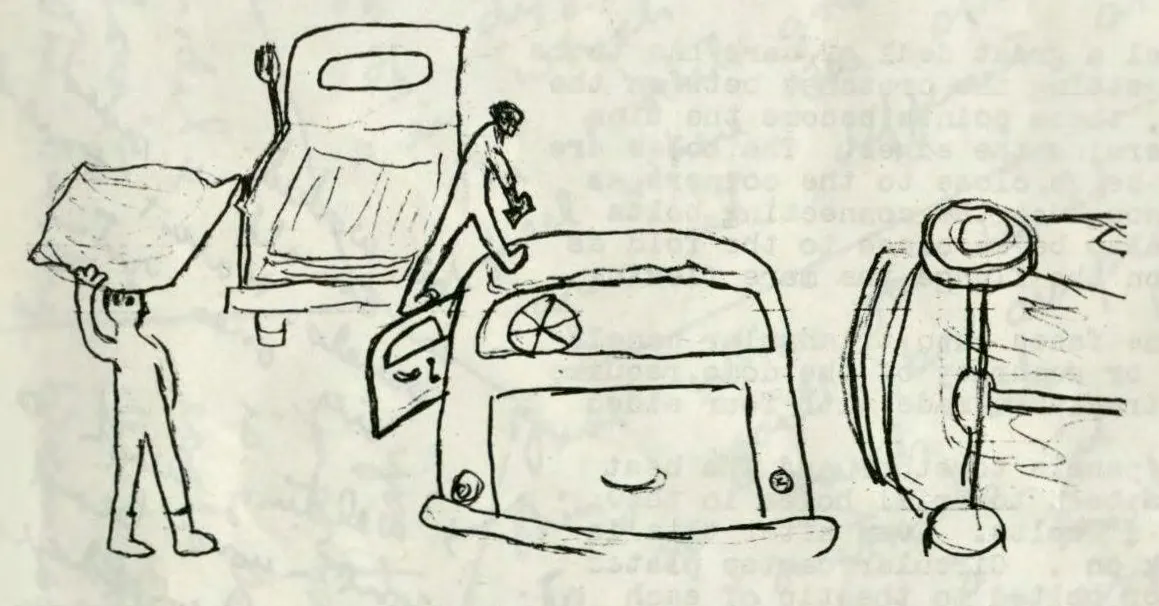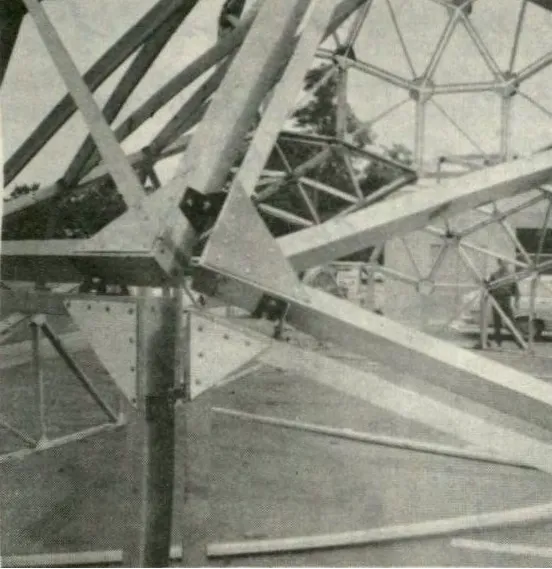1967-73
Steve Baer
Case study by:
Emily Silva,Fri Oct 09 2015
Manera Nueva

Introduction
The year is 1968. I have made a pit stop off the highway, and am heading north down an old dirt road in Placitas, New Mexico. To the south, rapid changes are happening in Albuquerque as the city multiplies its nodes of commerce to accommodate a growing suburban community. This decentralization from downtown promotes new shopping centers and is my reason for travel. I am in search of a Santa Fe “charm” and aesthetic with which to ornament my newest development in Albuquerque. The post-war housing market is in full swing, and I will cash in.
The summer sun beats down on the hood of my car, and a brilliant red reflects into the desert landscape. I pull into a local motel to take a dip in the pool and ponder the very short distance I have traveled so far: a moment to soak in the rural atmosphere and escape from the people just a short distance away in Albuquerque. I park, glance back, and think about how dazzling my Cadillac looks in the summer sun. Just a few hours sunbathing at the pool and I feel cleansed. Though only a half hour away, I am sure I will see Santa Fe, its plazas, the culture, with a whole new set of eyes.
But just as I approach the parking lot, I realize something is very wrong. I remove my eyeglasses, clean the lenses, place them back on my nose. My car, less dazzling now, was not a convertible when I left it last. Sitting banged up and bruised, the top of my car has been hacked off. I look around for relief of any kind. How could this be?
With no one in sight, I take off in my vehicle heading further and further down the dirt road in Placitas. Just fifteen minutes down the road, I must be hallucinating. To my left, floating among the local grasses, a dome emerges. Bright blues, shiny reds, clad with triangular and hexagonal panels: now, multiple domes enter my sight. It is as though I have entered a Vonnegut novel, and traveled to the alien planet of Tralfamadore.1 I park. Nothing is stopping me from entering the countercultural commune at which I have arrived. I decide to run, gathering speed, but there, just ten feet in front of me, stands an axe. I look ahead upon the domes with their glossy panels. I retreat just a few steps. It is in that moment that I recognize my Cadillac top, now turned into building material for an experimental utopia—Manera Nueva.2
Manera Nueva, an Alternative Architecture
Manera Nueva, Spanish for “new way,” rose in Placitas, New Mexico as a community built on anti-capitalist and anti-consumerist ideals. Its residents and resident-builders sought to revert to the essentials of simpler times. The domes that made up this settlement – called “zomes” – were constructed from found materials.3 Most remarkable among these were car tops, which, used as exterior cladding, appeared as a colorful patchwork rising above the desert landscape. These suggested the do-it-yourself nature that pervaded the experiment at Manera Nueva and similar settlements, as well as their inhabitants’ frustration with the culture and objects that marked the postwar age. Constructed as a commune, Manera Nueva was to benefit its inhabitants through an economy of shared resources. In doing so, it represented new ideas and methods that were intended to provide freedom from consumerism and a utopian alternative to mid-century capitalism.
Arriving amidst the larger social movements of the late 1960s and a broader, growing frustration with modernism, Manera Nueva represented a form of “countercultural” architecture. Countercultural architecture refers to two types of alternative, experimental approaches that emerged in this era: on one hand, socially, politically, economically, and culturally critical schemes that came from architects themselves; on the other, similarly provocative and critical approaches that came from those operating outside the design fields, who likewise intervened in the built environment. Manera Nueva’s primary designer and protagonist, Steve Baer, belongs in the second category, as a mathematician and inventor who connected to architecture through an interest in geometry.4 Baer, born in 1938 in Los Angeles, studied at Amherst College in 1956 and returned to Los Angeles soon after. He completed some studies at UCLA, but later returned to Amherst to study number theory and calculus. By the end of the 1950s, he had moved to the Southwest, settling in Albuquerque. By 1960, he had joined the U.S. Army and, with his wife Holly, relocated to Germany. He returned to the U.S. several years later, moving back to Albuquerque and finding a fertile ground for his unconventional interests in the new communal experiments of the mid-1960s.
Drop City
Baer’s involvement took form locally at Manera Nueva, beginning in 1967, and regionally at Drop City, the Placitas commune’s famous predecessor in southern Colorado. Drop City, in existence from 1965 to 1973 and located in Trinidad, Colorado just north of the New Mexico border, was the first anarchic commune in the Southwest. It exemplified the American countercultural approach that sparked the commune movement. The commune’s founders, Clark Richert, JoAnn Bernofsky, and Gene Bernofsky, met while studying at the University of Kansas. Inspired by artists like John Cage and Allan Kaprow, they sought to develop a community revolving around new kinds of human interaction with art. Their early experiments took the form of so-called “droppings” that sought to dematerialize art and reframe reality. For example, one “dropping” took the form of a performance that entailed placing an elaborate dinner set-up outdoors, with no one sitting at the table. The dinner was free to anyone who wanted to take a seat. Drop City proved the culmination of these efforts to blend art and everyday life; it became an unscripted art installation whose residents would construct it, inhabit it, and operate it. As part of an experimental living space, Drop City’s residents, including Richert and the Bernoskys, sought to distance themselves from a highly consumerist society at a time when suburban neighborhoods pressured consumers in the direction of a mundane routine. Drop City tapped into the broader communal trend of the era, whose residents typically disagreed with the international political climate, focusing on a peaceful network of shared ecological and non-monetary values. In short, they sought to bring the larger concerns of the late 1960s – individual freedom, frustration with capitalism, and interest in new means of living – to this vast acreage, as a new kind of community.5
Though a social, political, and economic experiment, architecture also played a central role in Drop City. Richert and the Bernoskys sought an architectural vernacular for Drop City that marked its alternative social ideals and their interest in art-as-life. They initially found one in Buckminster Fuller’s geodesic domes, after attending his lecture in Boulder, Colorado in 1965. The radical, space-age look of Fuller’s domes appealed to the founders of Drop City. In the geodesic dome, they saw a form that people without architectural “expertise” could build themselves. They soon found a new collaborator in Steve Baer, however, who had his own interest in dome-based architectural forms. Baer approached the “Droppers” a year into the Drop City experiment, during which time he was teaching in the architecture department at the University of New Mexico. He needed help to further develop research he had been pursuing on the geometry of the polyhedron and saw an opportunity in the dome-related experiments already underway just across the state line. The commune’s residents, who faced the daunting task of building their community themselves, welcomed his involvement.6
In the Zome
It was at Drop City that Baer first introduced his zome, a dome-like structure that required fewer parts, allowed greater formal flexibility, and permitted greater freedom for additions or alterations. The word “zome” came from Steve Durkee, during a conversation with Baer about the properties of zonahedra, which were not actually domes because they lacked symmetry. Baer was initially shy about using the word because he did not want to seem to be advertising his idea, yet he came to embrace the term. Also influenced by Buckminister Fuller, Baer wrote to him to introduce his experiments with the zonahedra and ask about Fuller’s interest in stretching the geometry of the geodesic dome that he had claimed to invent. Fuller wrote back, but with little interest. Baer later questioned whether Fuller had actually “invented” the geodesic dome after seeing an engineering book with an image of a planetarium, built in Germany in 1922, that utilized a multi-frequency geodesic dome.7 Though Fuller did not find much interest in the zome, it proved Baer’s most important architectural contribution.
Baer developed his techniques for Manera Nueva from his early experiments at Drop City. He attempted some of his models in collaboration with students at the University of New Mexico. These trials led to the development of edge members for the angled prefabricated panels used at both Drop City and, later, Manera Nueva. These members could support the structures and used methods and tools that were workable for novice builders, turning the democratic, do-it-yourself principle of the commune into architectural form. Eventually three of Baer’s signature domes took form at Drop City—multicolored, intersecting structures that sat brightly on its brown landscape. But despite early architectural successes in Trinidad, and some social successes too, Drop City’s honeymoon period proved relatively short. With its self-sustaining model, Drop City lacked needed funds, and the very success of the commune movement also created new problems. Over its first couple years of existence, Drop City became less about artistic ambitions than its founding members had once hoped, and longtime residents found peril in an open-door policy that brought new residents who did not share the founders’ values. As a result, Baer left Drop City in 1967 and came to Placitas, twenty-five miles northeast of Albuquerque, to found Manera Nueva, sometimes called “Drop South” to indicate its relation to its predecessor.8
Dome Cookbook and other works
Manera Nueva took Baer’s geometric experiments in going beyond the cube – the canonical modernist form – to the periphery of Albuquerque, a city that modernism had undeniably transformed. Baer’s highly influential Dome Cookbook, published in 1968 to help fund Manera Nueva, served as the most permanent record of these experiments, lasting long after many of the communes themselves, including his own. It offered instruction to his peers, inscribing equations, trials, and building techniques in a do-it-yourself, sometimes stream-of-consciousness publication that provided a bible for the movement. Baer’s cookbook was the earliest of a wave of West Coast cookbooks. In the wake of its publication, an influx of such guides from artists and architects “repulsed by American conventions” sprang up, all accessible and written so that anyone could follow. For example, Ken Isaacs’s How to Build Your Own Living Structures (1974), a step-by-step guide to building modular, flexible, and multi-use living spaces for use in a rural or urban context, was one notable successor. The notorious Anarchist Cookbook by William Powell, then living in New York City’s Greenwich Village, was published in 1971 and also developed from Baer’s “cookbook” approach. Curtis Schreier and Chip Lord of the collaborative art and design group Ant Farm have also described Baer’s cookbook as an important influence, leading to the publication of their Inflatocookbook in 1973 to “spread knowledge to the people.” Schreirer has also suggested that do-it-yourself computing pioneer Don Lancaster drew his idea for electronic cookbooks from Baer.9
What these share, and what Baer’s Dome Cookbook exemplifies most notably, is an orientation to do-it-yourselfers, one that – as seen in Drop City – offered the idea that experts were not needed to build a new society. While mainstream skepticism understandably persisted in response to this idea, Baer continued to design and build his zomes at Manera Nueva as a way to show its possibility. In total, Baer designed four zomes for Manera Nueva, clustered forms that took a variety of shapes and served different purposes, but each following a characteristic rounded form. The largest, Baer explained in the Dome Cookbook, measured 750 square feet, with its sides measuring 28 feet by 34 feet, and reaching a height of 19 feet. Despite the fairly large proportions of these structures, each was intended to be resident built.10
In keeping with this DIY ethos, Baer approached the form of the zome not only from an experimental design stance, but also from a radical fabrication stance. This is where car tops come into the story. Whether obtained legally or, in some cases, illegally, these were the primary building material for Baer’s architectural experiments at Manera Nueva and Drop City. This unconventional architectural component symbolized the communes’ broader interest in taking everyday materials that already existed and finding new uses for them. In the Dome Cookbook, Baer described the appeal of car tops as related to their intrinsic qualities: strong, cheap, and having “excellent” paint jobs. Explaining that most of these car tops could be removed with an axe, Baer wrote that an experienced person could obtain as many as five or six car tops at a junk yard in as little as an hour. Closely packed cars helped to expedite the process, as the person would never have to touch the ground between. Once gathered, residents shaped the car tops into polygons that served the purposes of Baer’s characteristic form. As he described, “A zonahedron is a convex polyhedron all of whos[e] faces are zonagons and a zonagon is a polygon whose sides are in equal and parallel pairs.” Residents used nails to connect these hexagons, octagons, and parallelograms, among other shapes, to a structure made of scrap wood, again keeping with their ethos of reuse, recycling, and reappropriation. “Every edge member, every cross piece and every corner brace is made of pine 2”x6” which the mill had been unable to sell as #2 because of round bark covered edges and other defects,” Baer wrote.11
This process demonstrated the improvisational approach of Southwestern communes in general and the specific formal qualities of Manera Nueva, Drop City, and their siblings, but should not be understood as indicative of a low-tech or shoddy approach to construction. As Baer described, the form gained remarkable strength as its components came into place. After installing braces at Manera Nueva, Baer found that “[y]ou could climb anywhere on the cluster.” As he explained, “it swayed and sagged in places but never deformed dangerously.” As they nailed the car top “shingles” in place, Baer and his fellow builders found that each of the zomes in turn solidified the rigidity of its neighbors, all of which merged into each other. The completed structures housed living functions – places to sleep or to cook – and took an outward form that looked very much like a patchwork quilt, with a variety of shapes and colors assembled into a cohesive whole. But their rigidity and stability suggested the sophistication of Baer’s geometric experiments, which allowed very basic materials to come together as a new kind of architecture – and a new mode of living – in the New Mexico desert. The zomes of Manera Nueva twisted modernism’s interest in new technologies, and the material of one of modernism’s greatest inventions, the car, into bulbous, surreal forms that sought to model a new civilization.12
Legacy
Experimental communities like Manera Nueva met a variety of fates. As they evolved amidst changes in the broader culture, some folded, often as a result of conflict between residents, though not always. Manera Nueva ceased to exist in 1973; the specifics of its demise are difficult to uncover. But other communes in Placitas, which proved a hotbed of such experiments, lasted much longer, as did their peers elsewhere in the Southwest and in other regions. Some remained fully intact, while others transformed into more conventional living arrangements, with homes becoming privately owned by residents with independent incomes and increasingly independent lives.13
Yet Baer’s legacy proved more lasting than the relatively short-lived communes where he tested his architecturally innovative ideas. In 1969, he organized the ALLOY conference in an abandoned tile factory near La Luz, New Mexico.14 Attendees discussed building materials, structures, energy consumption, and human consciousness, demonstrating the many intersecting fields that were understood as related to architecture by the late 1960s. Writers from the Whole Earth Catalog, considered the manual of the countercultural movement and an indispensable resource for its participants, were among those in attendance. Indeed, Baer and his work were frequently mentioned in the catalog, from its very first issue. Here, at least, Baer held a place right alongside Fuller.15
If experiments like Manera Nueva did not fundamentally change the nature of human civilization in the late twentieth century, Baer’s work here and at Drop City can be said to have anticipated – and likely influenced – the architecture that followed, as architects sought yet more geometric alternatives to the forms of mid-century modernism. The formulas found in the Dome Cookbook utilized modern tools and machines, but without the advanced computational techniques that would arrive in later decades, they faced technological limitations that prevented further exploration into more irregular shapes. As computing power and access increased, however, these kinds of forms became more common and more complex. The blob-like forms that architecture embraced by the 1990s followed a genealogical line from the kinds of shapes seen in the Dome Cookbook and at Manera Nueva.
Baer himself continued to practice his principles. Today he lives in one of his zomes in Corrales, New Mexico, near Albuquerque. Like many of his peers, his broader interests in new ways of living and using resources found a home in the growing environmental movement in architecture. In the years following Manera Nueva, he became an active proponent and innovator of architecture that makes use of solar energy. He is the inventor of passive solar equipment for the building industry, an advocate for low-cost passive systems, and the author of several books related to that topic.16 He holds several patents in the field and has long led the Albuquerque-based Zomeworks Corporation, which sells these solar innovations today. Manera Nueva proved a brief experiment. But our movement toward greater sustainability in everything from architecture to fashion to the foods we eat suggests how radical ideas from Manera Nueva and its sister communities took contemporary forms that have become domesticated yet nevertheless transformative.
Footnotes
-
Kurt Vonnegut, The Sirens of Titan (New York: Delacorte Press, 1959) ↩
-
Andrew Blauvelt, ed., Hippie Modernism: The Struggle for Utopia (Minneapolis: Walker Art Center, 2015); Erin Elder, “How to Build a Commune: Drop City’s Influence on the Southwestern Commune Movement,” in West of Center: Art and the Counterculture Experiment in America, 1965-1977, ed. Elissa Auther and Adam Lerner (Minneapolis: University of Minnesota Press, 2012), 10-11 ↩
-
Steve Baer, Dome Cookbook (Corrales, NM: Lama Foundation, 1968). ↩
-
Beatriz Colomina, ed., Clip Stamp Fold: The Radical Architecture of Little Magazines, 196X to 197X (Barcelona: Actar, 2011); Constance M. Lewallen and Steve Seid, Ant Farm, 1968-1978 (Berkeley: University of California Press, 2004), 53. ↩
-
Elder 3, 6. ↩
-
Ibid., 9-11. ↩
-
Dome Cookbook, 21, 38. ↩
-
Dome Cookbook, 19, 25; Elder 11, 14-15; Timothy Miller, The 60s Communes: Hippies and Beyond (Syracuse: Syracuse University Press, 1999), 67-69. ↩
-
Elder, 10; Ken Isaacs, How to Build Your Own Living Structures (New York: Harmony Books, 1974); Miller; Colomina, 410. ↩
-
Elder, 79; Dome Cookbook, 1, 24. ↩
-
Dome Cookbook, 21, 24, 27. ↩
-
Ibid, 24. ↩
-
Ibid., 86. ↩
-
Elder, 18. ↩
-
Whole Earth Catalog (Menlo Park, CA: Portola Institute, Inc., 1968). ↩
-
Steve Baer and William A. Shurcliff, Subsidizing the Sun (Corrales, NM: S. Baer, 1988), 10. ↩


